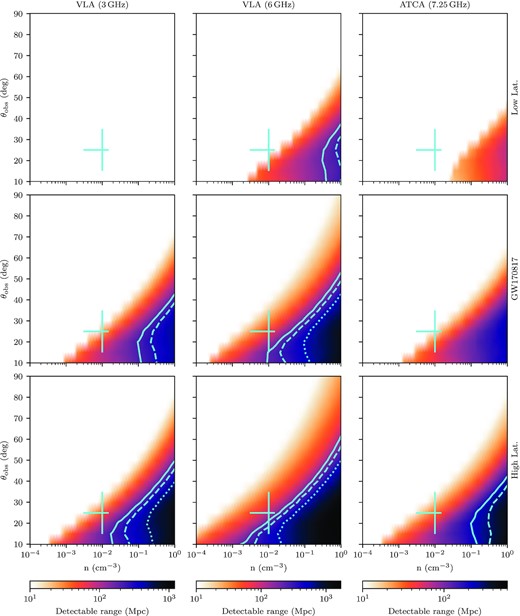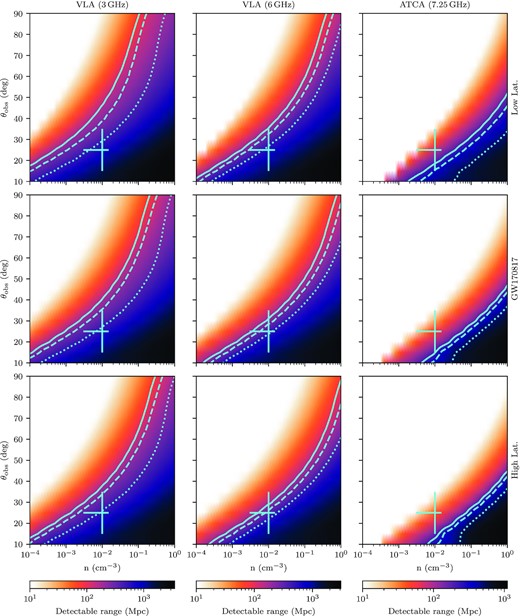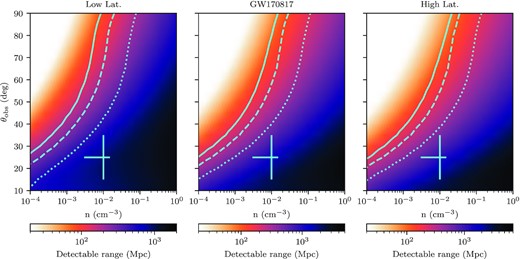-
PDF
- Split View
-
Views
-
Cite
Cite
Dougal Dobie, David L Kaplan, Kenta Hotokezaka, Tara Murphy, Adam Deller, Gregg Hallinan, Samaya Nissanke, Erratum: Constraining properties of neutron star merger outflows with radio observations, Monthly Notices of the Royal Astronomical Society, Volume 505, Issue 2, August 2021, Pages 1614–1617, https://doi.org/10.1093/mnras/stab1477
Close - Share Icon Share
In Dobie et al. (2020) we discuss the detectability of interstellar scintillation, centroid motion and outflow structure of neutron star merger afterglows and compare that to the corresponding detectability of gravitational waves from these events.
or roughly 10 per cent lower than stated in the original manuscript (Dobie et al. 2020). This change does not impact the conclusions of the paper, but does mean that the contours showing the gravitational wave detector inclination angle dependent range in figs 4, 5 and 6 are also incorrect. We provide updated versions below.
We also wish to correct the terminology used to describe the distance at which events can be detected. Throughout the original manuscript (Dobie et al. 2020) we incorrectly referred to the detector horizon, which is the maximum distance at which an event can be detected for optimal inclination angle and sky position. We instead should have referred to the detector range, i.e. the maximum distance at which an event can be detected, averaged across inclination angle and sky position.
There is one more change that the author ‘Dougal Dobie’ has now changed the institutions and his new affiliations are mentioned in this article.

Maximum distance at which diffractive scintillation is detectable for a range of electron density parameters. Top: typical scintillation parameters at low Galactic latitudes (10○ < |b| < 20○), ν0 = 18.1 GHz and |$\theta _{F0} = 1.5\, \mu$|as. Middle: ν0 = 10.3 GHz and |$\theta _{F0} = 2.9\, \mu$|as corresponding to the line of sight to GW170817. Bottom: typical scintillation parameters at high Galactic latitudes (60○ < |b| < 70○), ν0 = 7.82 GHz and |$\theta _{F0} = 3.9\, \mu$|as. This is shown for observations with the VLA at 3 GHz (left, not detectable for low |b|), 6 GHz (middle) and observations with the ATCA at 7.25 GHZ (right). The jagged edge is an artefact of using simulating models with steps in inclination angle of |$5\, deg$|. Contours corresponding to the inclination angle dependent LIGO range for O3 (135 Mpc, solid), design specifications (190 Mpc, dashed), and A+ (330 Mpc, dotted) are shown in blue. The blue cross corresponds to the typical short GRB circum-merger density and estimates for the inclination angle of GW170817. This was fig. 4 in the original manuscript (Dobie et al. 2020).

Maximum distance at which refractive scintillation is detectable for a range of electron density parameters. Top: typical scintillation parameters at low Galactic latitudes (10○ < |b| < 20○), ν0 = 18.1 GHz and |$\theta _{F0} = 1.5\, \mu$|as. Middle: ν0 = 10.3 GHz and |$\theta _{F0} = 2.9\, \mu$|as corresponding to the line of sight to GW170817. Bottom: typical scintillation parameters at high Galactic latitudes (60○ < |b| < 70○), ν0 = 7.82 GHz and |$\theta _{F0} = 3.9\, \mu$|as. This is shown for observations with the VLA at 3 GHz (left), 6 GHz (middle) and observations with the ATCA at 7.25 GHZ (right). The jagged edge is an artefact of using simulating models with steps in inclination angle of 5○. Contours corresponding to the inclination angle dependent LIGO range for O3 (135 Mpc, solid), design specifications (190 Mpc, dashed), and A+ (330 Mpc, dotted) are shown in blue. The blue cross corresponds to the typical short GRB circum-merger density and estimates for the inclination angle of GW170817. This was fig. 5 in the original manuscript (Dobie et al. 2020).

Maximum distance at which refractive scintillation is detectable with the Square Kilometre Array for a range of electron density parameters. Left: typical scintillation parameters at low Galactic latitudes (10○ < |b| < 20○), ν0 = 18.1 GHz and |$\theta _{F0} = 1.5\, \mu$|as. Middle: ν0 = 10.3 GHz and |$\theta _{F0} = 2.9\, \mu$|as corresponding to the line of sight to GW170817. Right: typical scintillation parameters at high Galactic latitudes (60○ < |b| < 70○), ν0 = 7.82 GHz and |$\theta _{F0} = 3.9\, \mu$|as. Contours corresponding to the inclination angle dependent LIGO range for O3 (135 Mpc, solid), design specifications (190 Mpc, dashed), and A+ (330 Mpc, dotted) are shown in blue. The blue cross corresponds to the typical short GRB circum-merger density and estimates for the inclination angle of GW170817. This was fig. 6 in the original manuscript (Dobie et al. 2020).
ACKNOWLEDGEMENTS
We thank Ilya Mandel for detailed discussions on the topic.
DATA AVAILABILITY
The data underlying this paper will be made available upon request.



